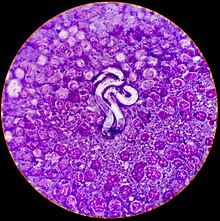

The microfilaria (plural microfilariae, sometimes abbreviated mf) is an early stage in the life cycle of certain parasitic nematodes in the family Onchocercidae.[1] In these species, the adults live in a tissue or the circulatory system of vertebrates (the "definitive hosts"). They release microfilariae into the bloodstream of the vertebrate host. The microfilariae are taken up by blood-feeding arthropod vectors (the "intermediate hosts"). In the intermediate host the microfilariae develop into infective larvae that can be transmitted to a new vertebrate host.
The presence of microfilariae in the host bloodstream is called "microfilaraemia". The success of filariasis eradication programs is typically gauged by the reduction in numbers of circulating microfilariae in infested individuals within a geographic area.[2]
Microfilaria may also refer to an informal "collective group" genus name, proposed by Cobbold in 1882. While a convenient category for newly discovered microfilariae which can not be assigned to a known species because the adults are unknown,[3] it is seldom used today.
- ^ Anderson, R.C. (2000) Nematode Parasites of Vertebrates: Their Development and Transmission. Second Edition. CABI Publishing: Wallingford, England, pp. 472–475. ISBN 0851997864
- ^ Farid, H.A., Z.S. Morsy, H. Helmy, R.M.R. Ramzy, M. El Setouhy, and G.J. Weil (2007) "A critical appraisal of molecular xenomonitoring as a tool for assessing progress toward elimination of lymphatic filariasis." American Journal of Tropical Medicine and Hygiene 77(4):593-600.
- ^ Purnomo; Bangs, M.J. (1995) "Microfilaria sundaicus sp.n., a Chabfilaria-like parasite (Filarioidea: Onchocerciae) from the blood of the horseshoe bat (Rhinolophus affinis) in Flores, Indonesia". Journal of the Helminthological Society of Washington 62(1):32-34.